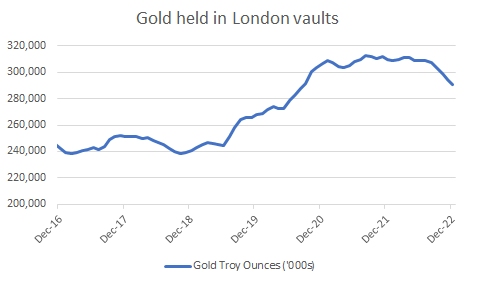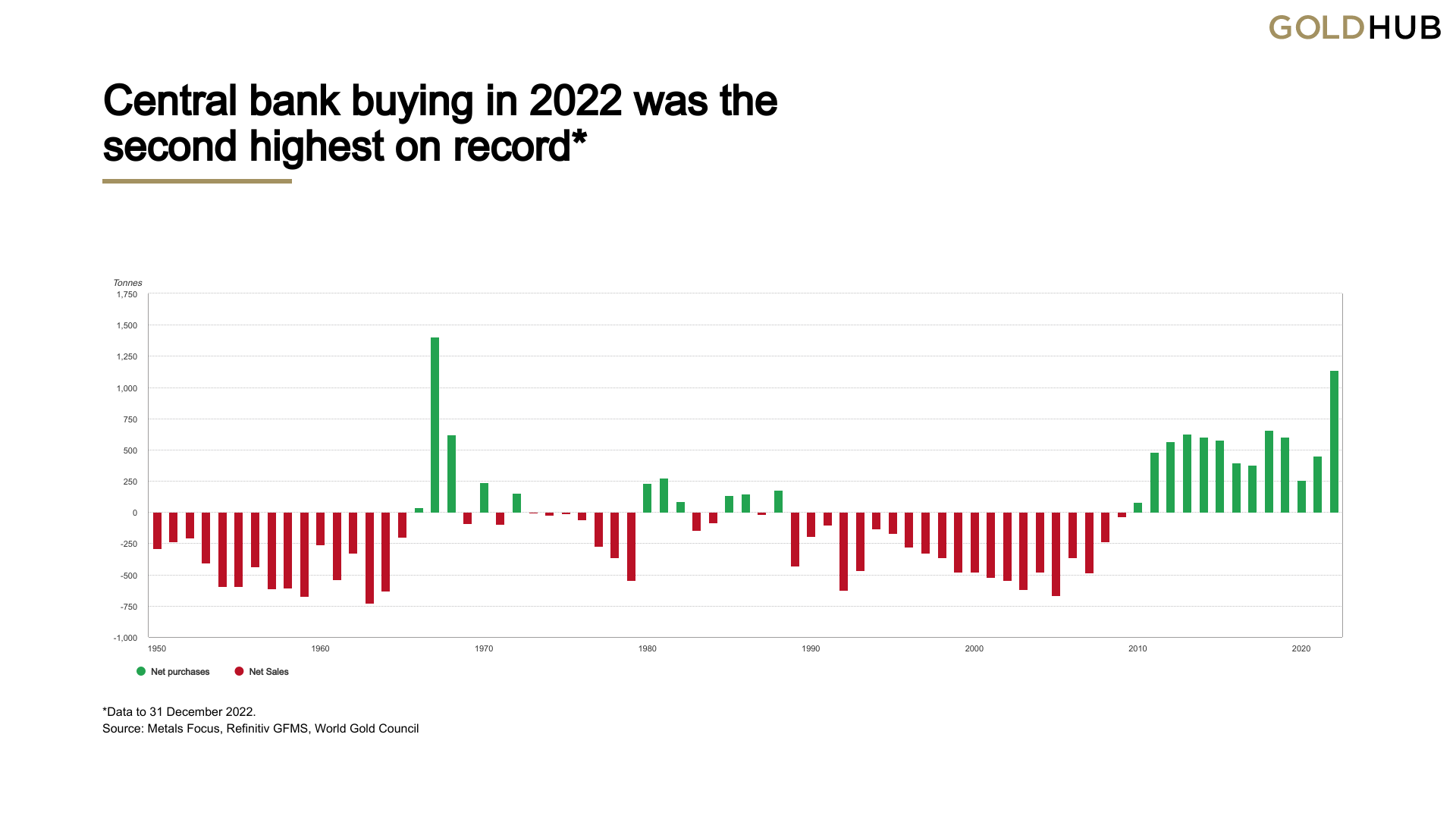Sanctions imposed on Russia after its invasion of Ukraine have caused London, the world’s major bullion trading market, to shrink.
According to the London Bullion Market Association (LBMA), gold held in London vaults fell by nearly 19m troy ounces (worth $37bn at today’s market price) during the course of 2022.

According to the World Gold Council, London accounts for around 70 percent of all wholesale trading in gold.
This trading centres on 400 troy ounce, so-called ‘Good Delivery’ bars, which meet pre-specified standards for weight, dimensions, fineness and marks.
On March 7 last year, following the imposition of sanctions on Russia by the US, UK and EU, the LBMA suspended six Russian gold and silver refiners from its good delivery list, meaning that any new bars they produced would no longer be accepted for settlement by the London bullion market.
However, bars produced by those six refiners prior to the imposition of sanctions would still be accepted for settlement, the LBMA said.
In September, the LBMA issued further guidance on what an acceptable bar is. It hinted at confusion in the London gold market, saying that some Russian 400-ounce bars had not been stamped with the month of production, making it difficult for market participants to decide whether or not to trade them.
gold held in London vaults fell by nearly 19m troy ounces (worth $37bn at today’s market price) during the course of 2022
The LBMA also suggested that gold bars marked in Cyrillic script by Kyrgyz and Kazakh refiners had been shunned by some traders, even though those countries were not subject to sanctions.
The LBMA has put the onus on the banks that custody gold for clients to attest that any Russian bars included in a shipment conform to its post-March rules.
If necessary, the LBMA said, the custody bank should provide a written statement to clients to that effect.
However, the LBMA went on, if clients held gold in an ‘unallocated’ account (where no individual good delivery bars are specified), the bullion bank could not give such assurances.
The sanctions appear to have led to confusion amongst the operators of gold tracker funds.
In December, Reuters reported that 11 exchange-traded funds (ETFs) had removed Russian-origin gold worth $2.2bn from their accounts between July and November 2022.
However, Reuters said, while some funds cut their holdings of Russian bars to zero, the two leading ETFs , BlackRock’s iShares Gold Trust and the World Gold Council’s SPDR Gold Shares ETF, actually increased their proportion of Russian gold over the period.
According to Reuters, the World Gold Council said its funds were guided by rules set by the London Bullion Market Association, under which pre-war Russian gold is eligible to trade. BlackRock declined to comment, Reuters said.
sanctions appear to have led to confusion amongst the operators of gold tracker funds
Another side-effect of the sanctions on Russia appears to be the large-scale shipment of gold from London to markets which have not signed up to sanctions.
British and Swiss customs data show huge shipments during 2022 from those markets to China, India and other countries in Asia and the Middle East, Reuters reported in December.
The shift in the gold market comes as central banks raised their bullion buying to the highest levels in 55 years.
Net buying by central banks of gold last year totalled 1,136 tonnes, the World Gold Council reported yesterday, the thirteenth consecutive year of net purchases and the highest total since 1967, just before the breakdown of the post-World War 2 Bretton Woods system of fixed exchange rates.

“It’s hardly surprising then that in a year scarred by geopolitical uncertainty and rampant inflation, central banks opted to continue adding gold to their coffers and at an accelerated pace,” the World Gold Council said yesterday.
It’s possible that central bank gold buying is even higher than reported, because the World Gold Council’s statistics exclude Russia, whose central bank stopped reporting its gold reserves after January 2022 as a result of the imposition of wartime censorship.
Before the war, Russia reported holdings of about $140bn of gold, around 20 percent of the country’s foreign reserves. As this gold was held in vaults in Moscow and St. Petersburg, it was beyond the reach of Western sanctions.
central banks raised their bullion buying to the highest levels in 55 years
In March last year, G7 countries seized around $300bn of Russia’s reserves in the form of foreign currency.
Russia’s central bank has reportedly been making some domestic purchases of gold, in a country accounting for some 10 percent of annual global production.
In the spring of 2022, according to Sergei Kashuba, the head of Russia’s Gold Industrialists’ Union, Russia’s central bank was able to buy more gold from domestic producers at a 12-15 percent price discount to London prices.
Russia’s central bank governor, Elvira Nabiullina, has reportedly been pushing for a relaxation of censorship on the country’s economic and financial statistics, including its gold reserves.
Meanwhile, Russian lawmakers are discussing the creation of a gold-backed digital currency (or ‘stablecoin’) to settle cross-border financial obligations with Iran, the Interfax news agency reported last week.
Either Russian vaults or local refiners could be used to supply the gold to back the stablecoins, said Anatoly Aksakov, head of the Russian parliamentary committee overseeing the financial markets.
Sign up here for the New Money Review newsletter
Click here for a full list of episodes of the New Money Review podcast: the future of money in 30 minutes
Related content from New Money Review
Johnson can’t stop Putin using Russia’s gold
Gold stablecoins boom despite concerns
Gold market liquidity seizes up









